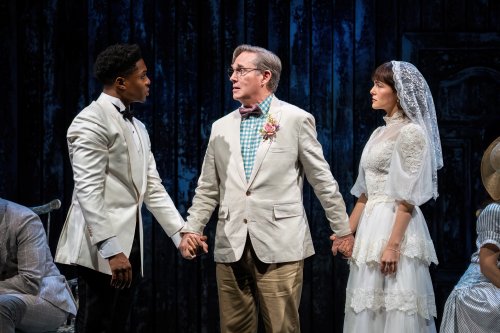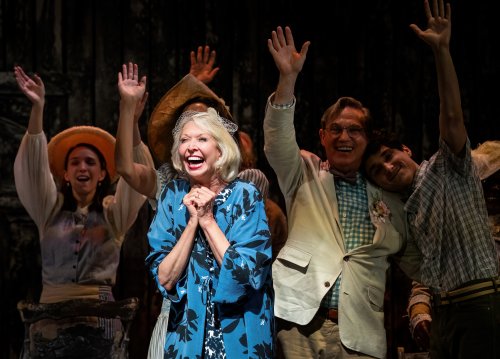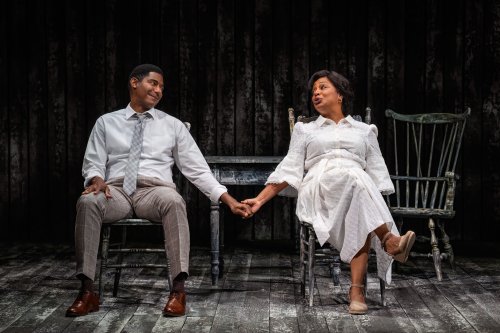Our Town
Grounded by Jim Parsons’ no-nonsense, emotionally charged performance as the Stage Manager and a multicultural cast split racially right down the middle, this is an "Our Town" perfectly suited for our times.

Jim Parsons as the Stage Manager and the cast of Thornton Wilder’s “Our Town” at the Ethel Barrymore Theatre (Photo credit: Daniel Rader)
If you thought that Thornton Wilder’s 1938 Pulitzer Prize-winner Our Town has little to say to our generation, was too sentimental, or lacked diversity, you will be amazed to find how Kenny Leon’s Broadway production, the first in over 21 years, successfully deals with those issues. Grounded by Jim Parsons’ no-nonsense, emotionally charged performance as the Stage Manager and a multicultural cast split racially right down the middle, this is an Our Town perfectly suited for our times. And if you think you know the play too well, you will be gratified to find that it seems like new in this rethought version that does not change one line of Wilder’s transcendent masterpiece.
Although originally set in Protestant, all-white Grover’s Corners, New Hampshire, in 1899, 1901, 1904 and 1913, Leon has solved that problem by making the Gibbs family Black and the Webb family white, and making the rest of the cast equally diverse. The costumes by Dede Ayite are a neat combination of both then and now which never seems out of keeping with the storyline. Leon sets the tone for his contemporary approach with an opening song “Braided Prayer” featuring prayers from Muslim, Jewish and Christian faiths. To make the play more up-to-date, this three act play is now performed without the two intermissions as a 140 minute one act.

Ephraim Sykes as George Gibbs, Richard Thomas as Editor Webb and Zoey Deutch as Emily Webb in a scene from Thornton Wilder’s “Our Town” at the Ethel Barrymore Theatre (Photo credit: Daniel Rader)
Wilder’s experimental play uses no scenery except for two tables, some chairs, a piano and usually two ladders for the upstairs bedroom windows of the young people. Here, however, Leon and set designer Beowulf Boritt have eliminated the ladders for two windows that open in the wooden back wall. Parsons’ description of the town and the street is so vivid that your imagination sees all that is meant to be there. Many of the stage effects are created by Allen Lee Hughes’ subtle lighting plot which takes us back to the end of the last century with lanterns both on the footlights and in Parsons’ hand. Leon has also added another one of the five senses by piping in the odors of heliotrope, vanilla, and bacon, one in each act. Professor Willard is here played by a woman, and as John McGinty playing milkman Howie Newsome is hearing challenged, the other actors speak to him in sign language, a new effect for this drama.
Wilder’s wise play depicts ordinary life in a typical country town in which nothing much has happened – but real life passed by. Act I show a day in our town: the milk and newspapers are delivered early in the morning. Mrs. Webb and Mrs. Gibbs send their children George, Rebecca, Emily and Wally off to school, their husbands Doc Gibbs and Editor Webb go about their routine. Their wives, next door neighbors, have a conversation about getting their husbands to take a vacation. George and Emily have a talk about collaborating on homework from their windows which are described as opposite each other. In the evening, the wives attend Choir practice while their husbands fret about how late they are coming home. The drunkenness of Organist Simon Stimson is the subject of the women’s gossip, while the fierce moonlight affects all who see it. Doc Gibbs points out that small-town life is not for everyone.

Ephie Aardema Sarnak, Julie Halston as Mrs. Soames, Richard Thomas and Hagan Oliveras in a scene from Thornton Wilder’s “Our Town” at the Ethel Barrymore Theatre (Photo credit: Daniel Rader)
Act II called “Love and Marriage” shows the wedding of George and Emily soon after high school graduation and reenacts the moment in high school when they first knew they were meant for each other, with Parsons playing Mr. Morgan behind the counter in the drugstore. We get the comments from wedding guest Mrs. Soames (a delightfully vociferous Julie Halston in the sort of role she does best) and Parsons as the minister gives his thoughts on how most people’s lives follow the same pattern. In this context, his statement that most people climb into their graves two by two has new meaning. Act III takes place in the cemetery and gives Wilder a chance to reveal what he thinks is eternal about human beings. During the funeral, it is stated that most people don’t live every moment “while they live it,” but life is “awful and wonderful” at the same time.
Parsons’ adrenaline charged performances as the Stage Manager and other characters gives the play an urgency it doesn’t always have and the fleet-footed pace of the rest of the actors gives us little time to notice the play’s original sentiment or lack of diversity. Ephraim Sykes is fine as the conflicted George Gibbs, while Zoey Deutch is amusing as the affected Emily Webb who as a girl puts on airs. Billy Eugene Jones is an understanding and compassionate Doc Gibbs while Richard Thomas as Editor Webb is ironic and satirical. Michelle Wilson’s Mrs. Gibbs is a low-key and understand woman while Katie Holmes fails to make Mrs. Webb her own. Sky Smith as both newspaper delivery boy Joe Crowell and his brother Si Crowell has the high spirits of teenage boys, while Safiya Kaijya Harris makes Rebecca a forward young lady. Donald Webber, Jr. as Simon Stimson makes his presence felt though he has few lines.

Billy Eugene Jones as Dr. Gibbs and Michelle Wilson as Mrs. Gibbs in a scene from Thornton Wilder’s “Our Town” at the Ethel Barrymore Theatre (Photo credit: Daniel Rader)
The most engaging scenic element is Justin Ellington’s sound design which fills the stage with the sound of train and factory whistles, school bells, milk bottles, cockcrow, horse’ whinnies, chickens cackling, thunder, church chimes, the town clock and newspapers skidding on the floor, as well as music for the choir practice and the later wedding march. All of this aural stimulation helps fill in for the missing scenery. The time and setting of the play in the program is listed in the program as pertinent “Now” and the play offers a timely message about how to live your life that we all need to be reminded of every once in a while. This Our Town fills the bill as an Our Town for our time.
Our Town (through January 19, 2025)
Ethel Barrymore Theatre, 243 W. 47th Street, in Manhattan
For tickets, visit http://www.ourtownbroadway.com
Running time: one hour and 50 minutes without an intermission






Leave a comment